Tesco's Operational Analysis: Accounting, HR, Legislation & Teams
VerifiedAdded on 2023/06/11
|14
|3815
|443
Report
AI Summary
This report provides an overview of key business operations, focusing on the importance of accounting, the different functions of the HR department, key features and impacts of employment legislation, team development stages, and various motivation theories. The report uses Tesco as a case study to illustrate these concepts, analyzing the company's financial performance and operational strategies. It delves into topics such as budgeting, decision-making, business performance measurement through accounting, employee relations, compensation, and the impact of leadership styles on employee motivation. The analysis also covers Belbin's team roles and Tuckman's stages of team development, providing a comprehensive view of how businesses operate and manage their resources and workforce, with the aim of improving productivity and achieving organizational goals. This document is available on Desklib, a platform providing a wealth of study tools for students.
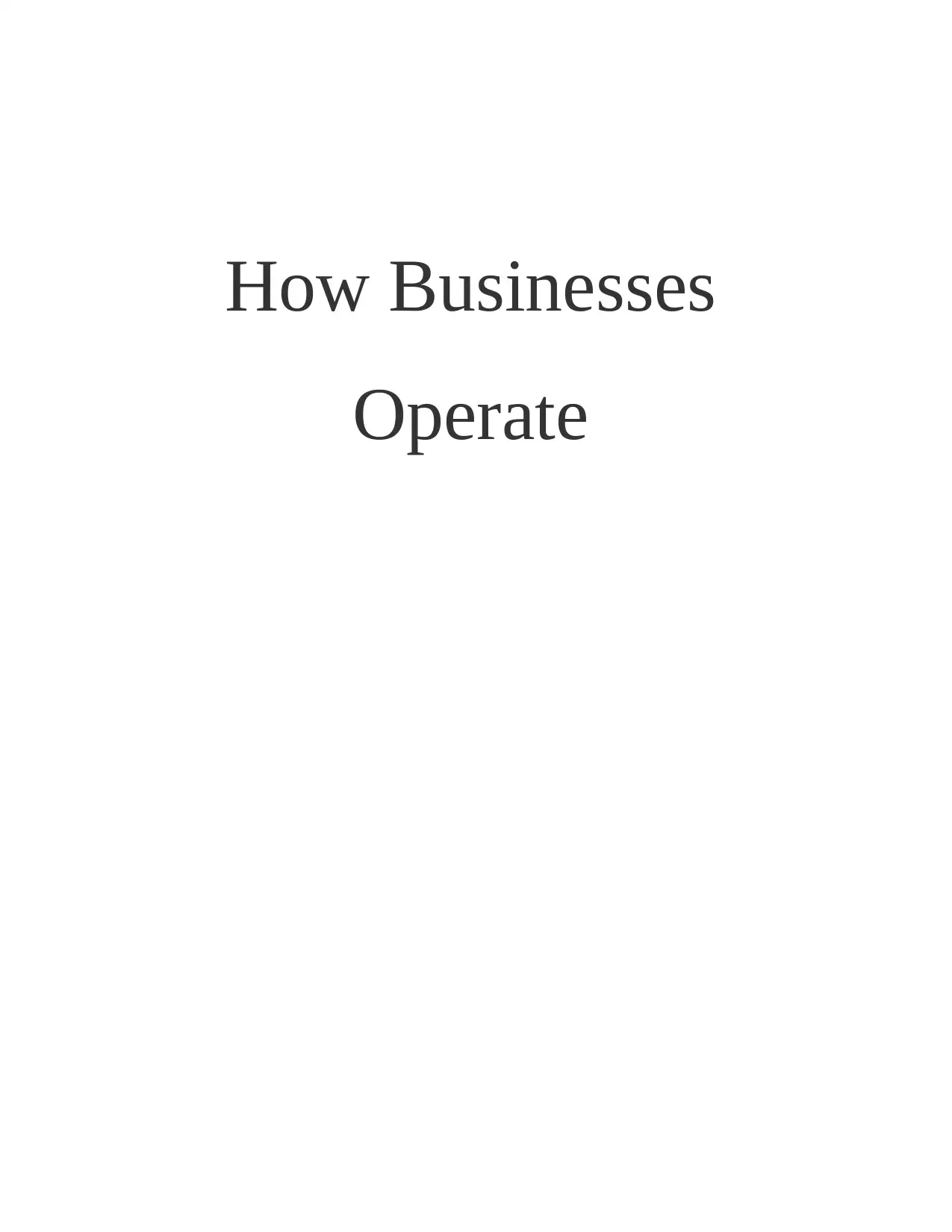
How Businesses
Operate
Operate
Paraphrase This Document
Need a fresh take? Get an instant paraphrase of this document with our AI Paraphraser
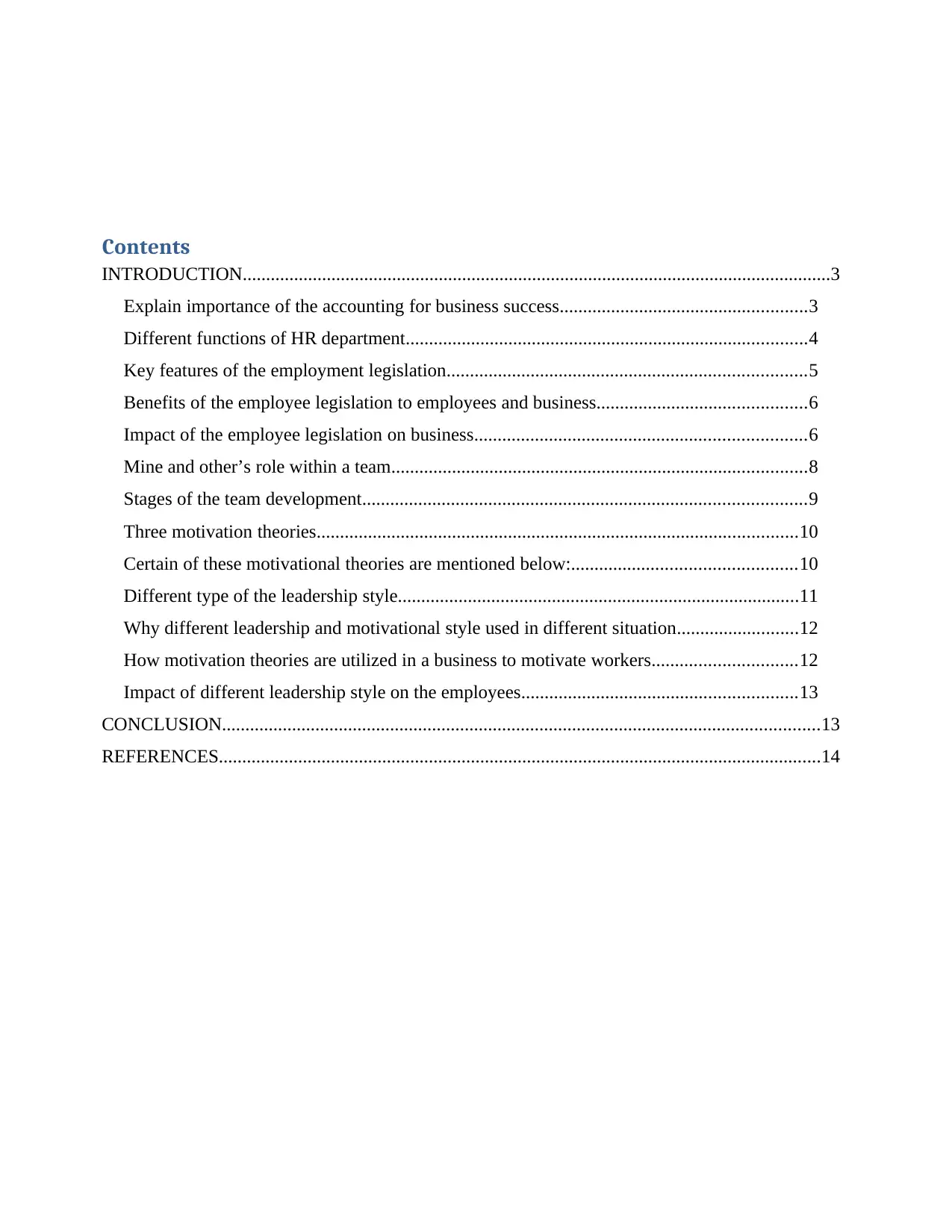
Contents
INTRODUCTION..............................................................................................................................3
Explain importance of the accounting for business success.....................................................3
Different functions of HR department......................................................................................4
Key features of the employment legislation.............................................................................5
Benefits of the employee legislation to employees and business.............................................6
Impact of the employee legislation on business.......................................................................6
Mine and other’s role within a team.........................................................................................8
Stages of the team development...............................................................................................9
Three motivation theories.......................................................................................................10
Certain of these motivational theories are mentioned below:................................................10
Different type of the leadership style......................................................................................11
Why different leadership and motivational style used in different situation..........................12
How motivation theories are utilized in a business to motivate workers...............................12
Impact of different leadership style on the employees...........................................................13
CONCLUSION................................................................................................................................13
REFERENCES.................................................................................................................................14
INTRODUCTION..............................................................................................................................3
Explain importance of the accounting for business success.....................................................3
Different functions of HR department......................................................................................4
Key features of the employment legislation.............................................................................5
Benefits of the employee legislation to employees and business.............................................6
Impact of the employee legislation on business.......................................................................6
Mine and other’s role within a team.........................................................................................8
Stages of the team development...............................................................................................9
Three motivation theories.......................................................................................................10
Certain of these motivational theories are mentioned below:................................................10
Different type of the leadership style......................................................................................11
Why different leadership and motivational style used in different situation..........................12
How motivation theories are utilized in a business to motivate workers...............................12
Impact of different leadership style on the employees...........................................................13
CONCLUSION................................................................................................................................13
REFERENCES.................................................................................................................................14
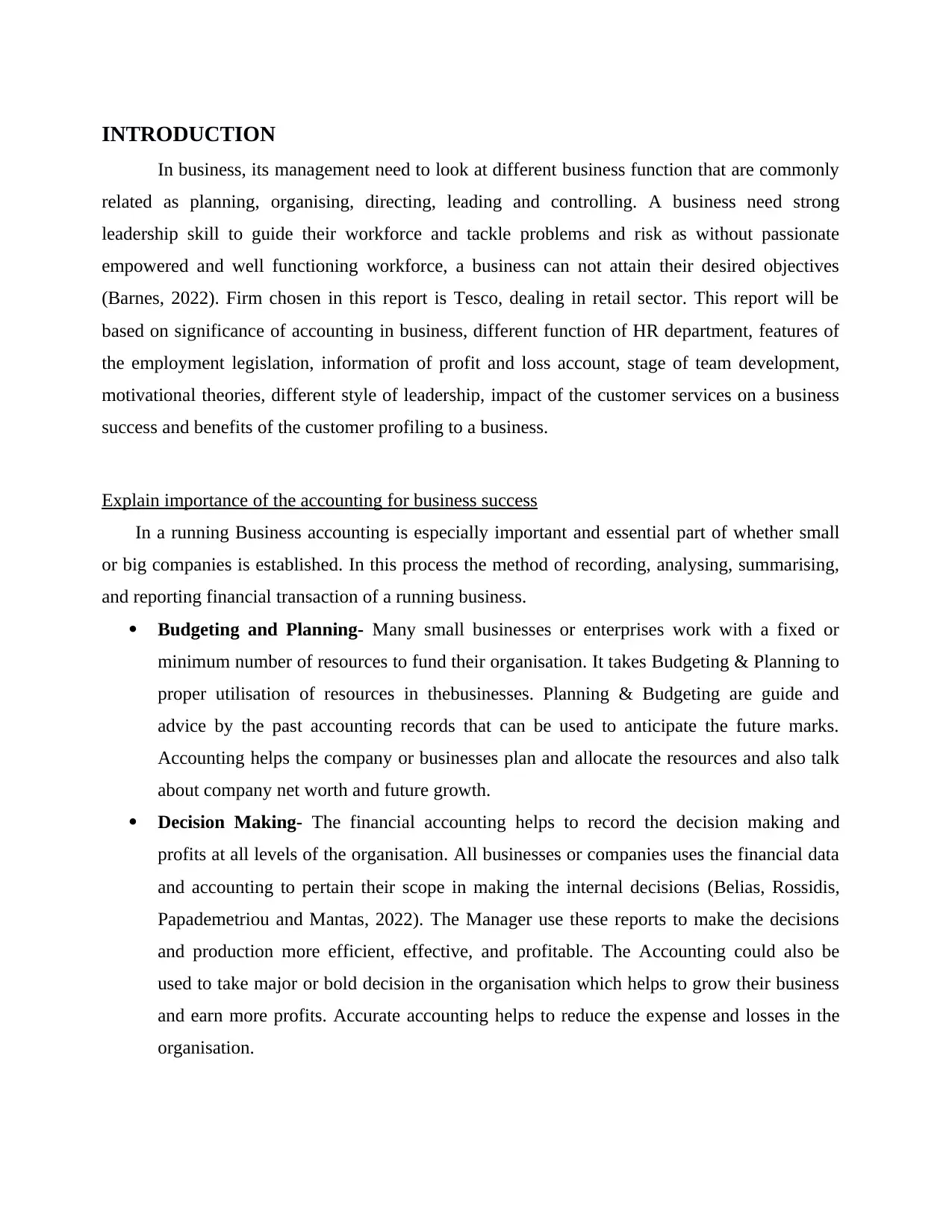
INTRODUCTION
In business, its management need to look at different business function that are commonly
related as planning, organising, directing, leading and controlling. A business need strong
leadership skill to guide their workforce and tackle problems and risk as without passionate
empowered and well functioning workforce, a business can not attain their desired objectives
(Barnes, 2022). Firm chosen in this report is Tesco, dealing in retail sector. This report will be
based on significance of accounting in business, different function of HR department, features of
the employment legislation, information of profit and loss account, stage of team development,
motivational theories, different style of leadership, impact of the customer services on a business
success and benefits of the customer profiling to a business.
Explain importance of the accounting for business success
In a running Business accounting is especially important and essential part of whether small
or big companies is established. In this process the method of recording, analysing, summarising,
and reporting financial transaction of a running business.
Budgeting and Planning- Many small businesses or enterprises work with a fixed or
minimum number of resources to fund their organisation. It takes Budgeting & Planning to
proper utilisation of resources in thebusinesses. Planning & Budgeting are guide and
advice by the past accounting records that can be used to anticipate the future marks.
Accounting helps the company or businesses plan and allocate the resources and also talk
about company net worth and future growth.
Decision Making- The financial accounting helps to record the decision making and
profits at all levels of the organisation. All businesses or companies uses the financial data
and accounting to pertain their scope in making the internal decisions (Belias, Rossidis,
Papademetriou and Mantas, 2022). The Manager use these reports to make the decisions
and production more efficient, effective, and profitable. The Accounting could also be
used to take major or bold decision in the organisation which helps to grow their business
and earn more profits. Accurate accounting helps to reduce the expense and losses in the
organisation.
In business, its management need to look at different business function that are commonly
related as planning, organising, directing, leading and controlling. A business need strong
leadership skill to guide their workforce and tackle problems and risk as without passionate
empowered and well functioning workforce, a business can not attain their desired objectives
(Barnes, 2022). Firm chosen in this report is Tesco, dealing in retail sector. This report will be
based on significance of accounting in business, different function of HR department, features of
the employment legislation, information of profit and loss account, stage of team development,
motivational theories, different style of leadership, impact of the customer services on a business
success and benefits of the customer profiling to a business.
Explain importance of the accounting for business success
In a running Business accounting is especially important and essential part of whether small
or big companies is established. In this process the method of recording, analysing, summarising,
and reporting financial transaction of a running business.
Budgeting and Planning- Many small businesses or enterprises work with a fixed or
minimum number of resources to fund their organisation. It takes Budgeting & Planning to
proper utilisation of resources in thebusinesses. Planning & Budgeting are guide and
advice by the past accounting records that can be used to anticipate the future marks.
Accounting helps the company or businesses plan and allocate the resources and also talk
about company net worth and future growth.
Decision Making- The financial accounting helps to record the decision making and
profits at all levels of the organisation. All businesses or companies uses the financial data
and accounting to pertain their scope in making the internal decisions (Belias, Rossidis,
Papademetriou and Mantas, 2022). The Manager use these reports to make the decisions
and production more efficient, effective, and profitable. The Accounting could also be
used to take major or bold decision in the organisation which helps to grow their business
and earn more profits. Accurate accounting helps to reduce the expense and losses in the
organisation.
⊘ This is a preview!⊘
Do you want full access?
Subscribe today to unlock all pages.

Trusted by 1+ million students worldwide
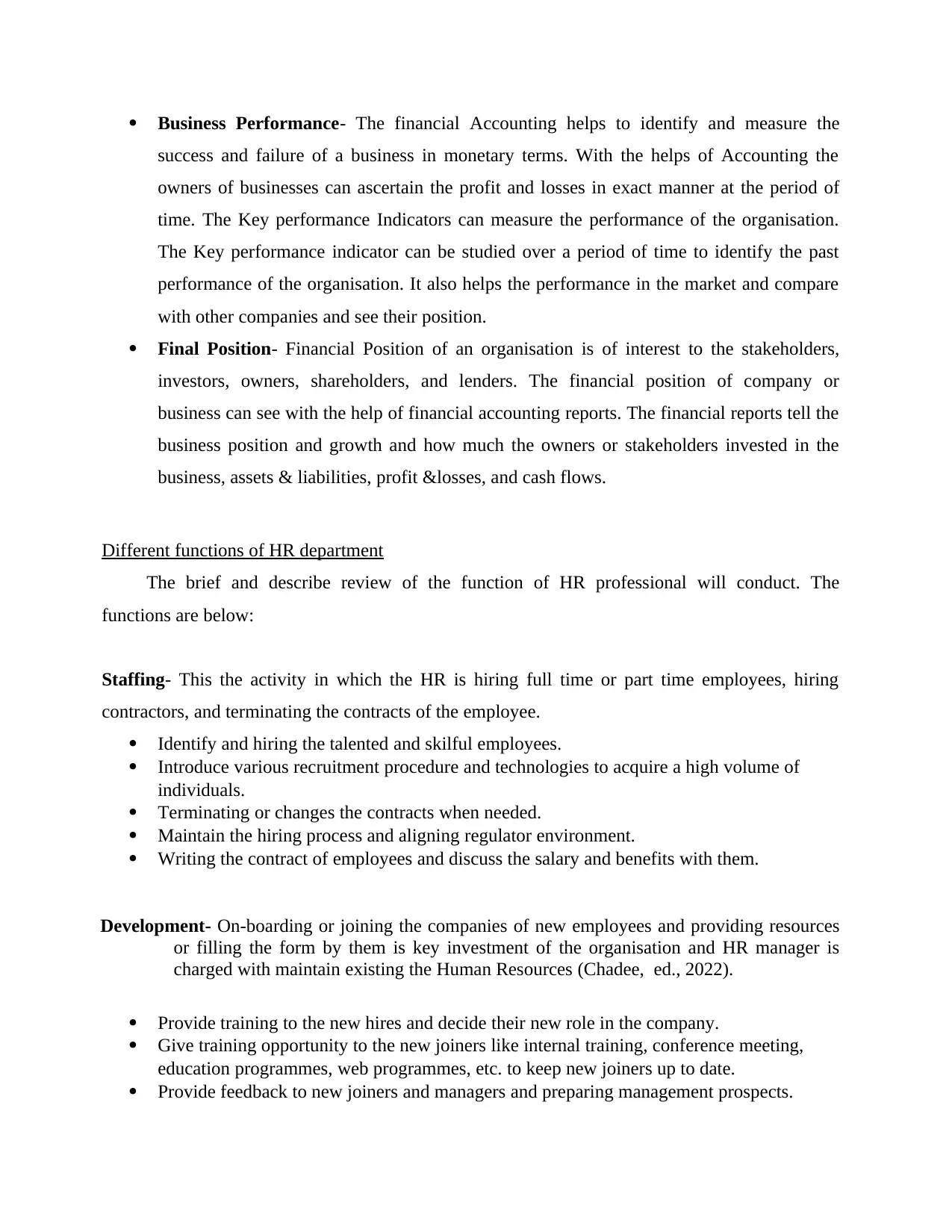
Business Performance- The financial Accounting helps to identify and measure the
success and failure of a business in monetary terms. With the helps of Accounting the
owners of businesses can ascertain the profit and losses in exact manner at the period of
time. The Key performance Indicators can measure the performance of the organisation.
The Key performance indicator can be studied over a period of time to identify the past
performance of the organisation. It also helps the performance in the market and compare
with other companies and see their position.
Final Position- Financial Position of an organisation is of interest to the stakeholders,
investors, owners, shareholders, and lenders. The financial position of company or
business can see with the help of financial accounting reports. The financial reports tell the
business position and growth and how much the owners or stakeholders invested in the
business, assets & liabilities, profit &losses, and cash flows.
Different functions of HR department
The brief and describe review of the function of HR professional will conduct. The
functions are below:
Staffing- This the activity in which the HR is hiring full time or part time employees, hiring
contractors, and terminating the contracts of the employee.
Identify and hiring the talented and skilful employees.
Introduce various recruitment procedure and technologies to acquire a high volume of
individuals.
Terminating or changes the contracts when needed.
Maintain the hiring process and aligning regulator environment.
Writing the contract of employees and discuss the salary and benefits with them.
Development- On-boarding or joining the companies of new employees and providing resources
or filling the form by them is key investment of the organisation and HR manager is
charged with maintain existing the Human Resources (Chadee, ed., 2022).
Provide training to the new hires and decide their new role in the company.
Give training opportunity to the new joiners like internal training, conference meeting,
education programmes, web programmes, etc. to keep new joiners up to date.
Provide feedback to new joiners and managers and preparing management prospects.
success and failure of a business in monetary terms. With the helps of Accounting the
owners of businesses can ascertain the profit and losses in exact manner at the period of
time. The Key performance Indicators can measure the performance of the organisation.
The Key performance indicator can be studied over a period of time to identify the past
performance of the organisation. It also helps the performance in the market and compare
with other companies and see their position.
Final Position- Financial Position of an organisation is of interest to the stakeholders,
investors, owners, shareholders, and lenders. The financial position of company or
business can see with the help of financial accounting reports. The financial reports tell the
business position and growth and how much the owners or stakeholders invested in the
business, assets & liabilities, profit &losses, and cash flows.
Different functions of HR department
The brief and describe review of the function of HR professional will conduct. The
functions are below:
Staffing- This the activity in which the HR is hiring full time or part time employees, hiring
contractors, and terminating the contracts of the employee.
Identify and hiring the talented and skilful employees.
Introduce various recruitment procedure and technologies to acquire a high volume of
individuals.
Terminating or changes the contracts when needed.
Maintain the hiring process and aligning regulator environment.
Writing the contract of employees and discuss the salary and benefits with them.
Development- On-boarding or joining the companies of new employees and providing resources
or filling the form by them is key investment of the organisation and HR manager is
charged with maintain existing the Human Resources (Chadee, ed., 2022).
Provide training to the new hires and decide their new role in the company.
Give training opportunity to the new joiners like internal training, conference meeting,
education programmes, web programmes, etc. to keep new joiners up to date.
Provide feedback to new joiners and managers and preparing management prospects.
Paraphrase This Document
Need a fresh take? Get an instant paraphrase of this document with our AI Paraphraser
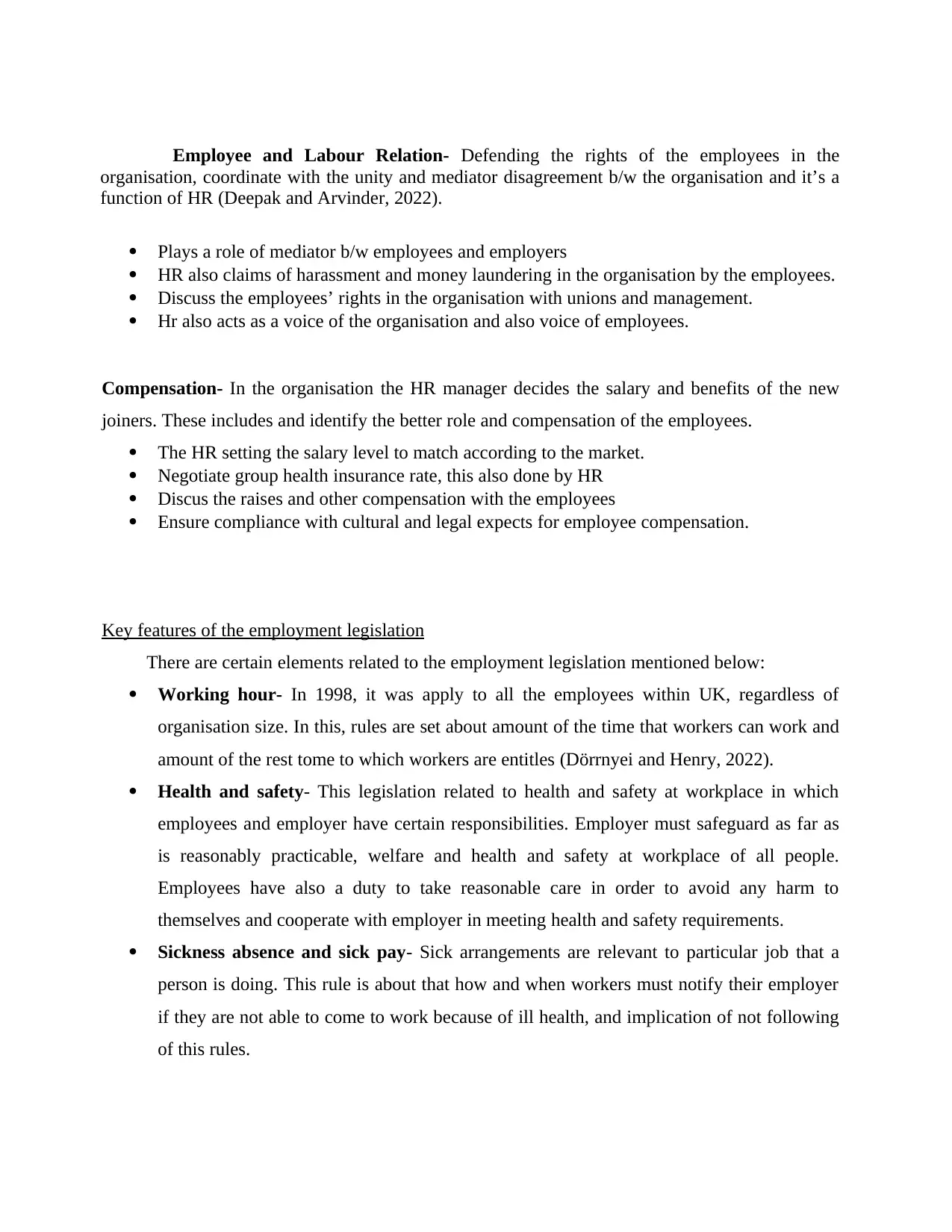
Employee and Labour Relation- Defending the rights of the employees in the
organisation, coordinate with the unity and mediator disagreement b/w the organisation and it’s a
function of HR (Deepak and Arvinder, 2022).
Plays a role of mediator b/w employees and employers
HR also claims of harassment and money laundering in the organisation by the employees.
Discuss the employees’ rights in the organisation with unions and management.
Hr also acts as a voice of the organisation and also voice of employees.
Compensation- In the organisation the HR manager decides the salary and benefits of the new
joiners. These includes and identify the better role and compensation of the employees.
The HR setting the salary level to match according to the market.
Negotiate group health insurance rate, this also done by HR
Discus the raises and other compensation with the employees
Ensure compliance with cultural and legal expects for employee compensation.
Key features of the employment legislation
There are certain elements related to the employment legislation mentioned below:
Working hour- In 1998, it was apply to all the employees within UK, regardless of
organisation size. In this, rules are set about amount of the time that workers can work and
amount of the rest tome to which workers are entitles (Dörrnyei and Henry, 2022).
Health and safety- This legislation related to health and safety at workplace in which
employees and employer have certain responsibilities. Employer must safeguard as far as
is reasonably practicable, welfare and health and safety at workplace of all people.
Employees have also a duty to take reasonable care in order to avoid any harm to
themselves and cooperate with employer in meeting health and safety requirements.
Sickness absence and sick pay- Sick arrangements are relevant to particular job that a
person is doing. This rule is about that how and when workers must notify their employer
if they are not able to come to work because of ill health, and implication of not following
of this rules.
organisation, coordinate with the unity and mediator disagreement b/w the organisation and it’s a
function of HR (Deepak and Arvinder, 2022).
Plays a role of mediator b/w employees and employers
HR also claims of harassment and money laundering in the organisation by the employees.
Discuss the employees’ rights in the organisation with unions and management.
Hr also acts as a voice of the organisation and also voice of employees.
Compensation- In the organisation the HR manager decides the salary and benefits of the new
joiners. These includes and identify the better role and compensation of the employees.
The HR setting the salary level to match according to the market.
Negotiate group health insurance rate, this also done by HR
Discus the raises and other compensation with the employees
Ensure compliance with cultural and legal expects for employee compensation.
Key features of the employment legislation
There are certain elements related to the employment legislation mentioned below:
Working hour- In 1998, it was apply to all the employees within UK, regardless of
organisation size. In this, rules are set about amount of the time that workers can work and
amount of the rest tome to which workers are entitles (Dörrnyei and Henry, 2022).
Health and safety- This legislation related to health and safety at workplace in which
employees and employer have certain responsibilities. Employer must safeguard as far as
is reasonably practicable, welfare and health and safety at workplace of all people.
Employees have also a duty to take reasonable care in order to avoid any harm to
themselves and cooperate with employer in meeting health and safety requirements.
Sickness absence and sick pay- Sick arrangements are relevant to particular job that a
person is doing. This rule is about that how and when workers must notify their employer
if they are not able to come to work because of ill health, and implication of not following
of this rules.
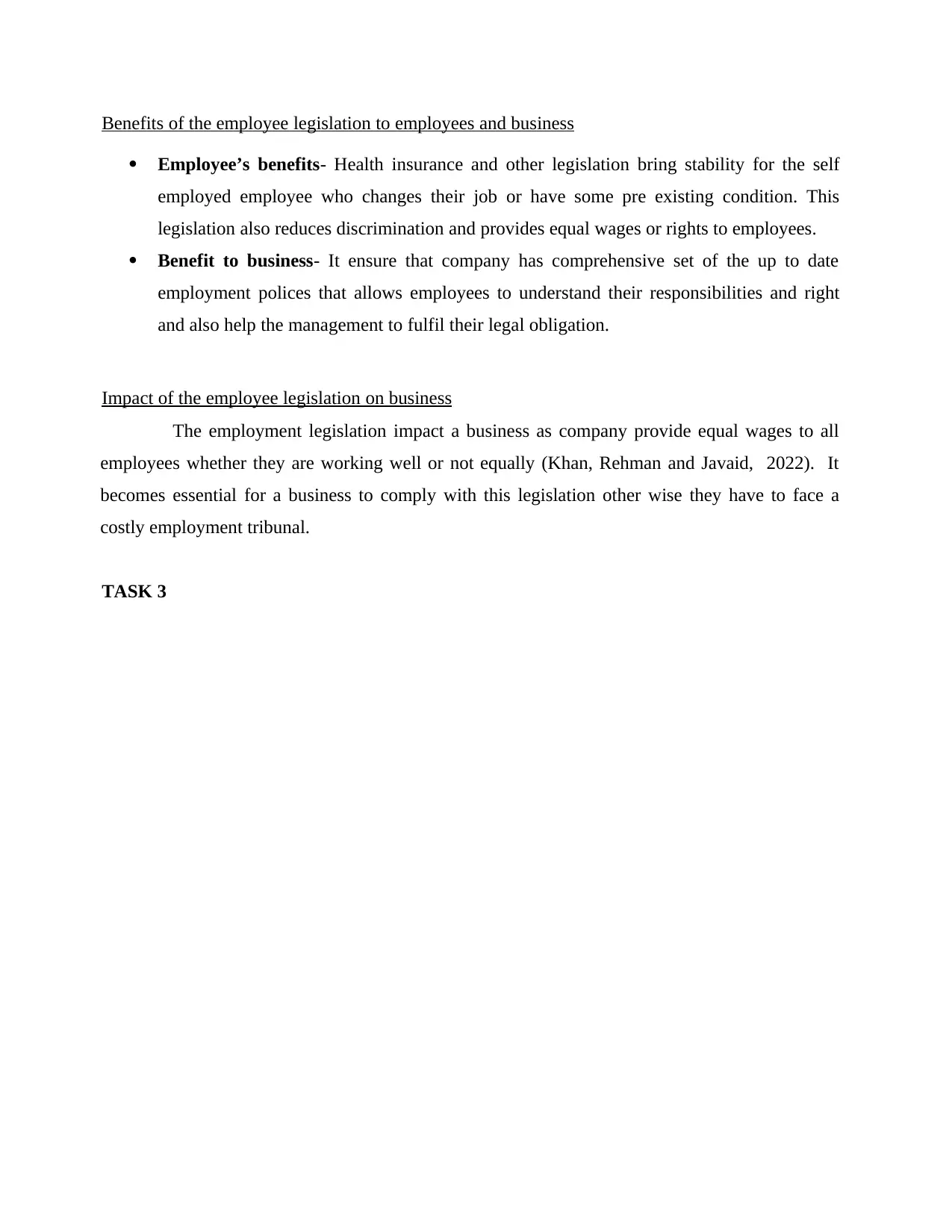
Benefits of the employee legislation to employees and business
Employee’s benefits- Health insurance and other legislation bring stability for the self
employed employee who changes their job or have some pre existing condition. This
legislation also reduces discrimination and provides equal wages or rights to employees.
Benefit to business- It ensure that company has comprehensive set of the up to date
employment polices that allows employees to understand their responsibilities and right
and also help the management to fulfil their legal obligation.
Impact of the employee legislation on business
The employment legislation impact a business as company provide equal wages to all
employees whether they are working well or not equally (Khan, Rehman and Javaid, 2022). It
becomes essential for a business to comply with this legislation other wise they have to face a
costly employment tribunal.
TASK 3
Employee’s benefits- Health insurance and other legislation bring stability for the self
employed employee who changes their job or have some pre existing condition. This
legislation also reduces discrimination and provides equal wages or rights to employees.
Benefit to business- It ensure that company has comprehensive set of the up to date
employment polices that allows employees to understand their responsibilities and right
and also help the management to fulfil their legal obligation.
Impact of the employee legislation on business
The employment legislation impact a business as company provide equal wages to all
employees whether they are working well or not equally (Khan, Rehman and Javaid, 2022). It
becomes essential for a business to comply with this legislation other wise they have to face a
costly employment tribunal.
TASK 3
⊘ This is a preview!⊘
Do you want full access?
Subscribe today to unlock all pages.

Trusted by 1+ million students worldwide
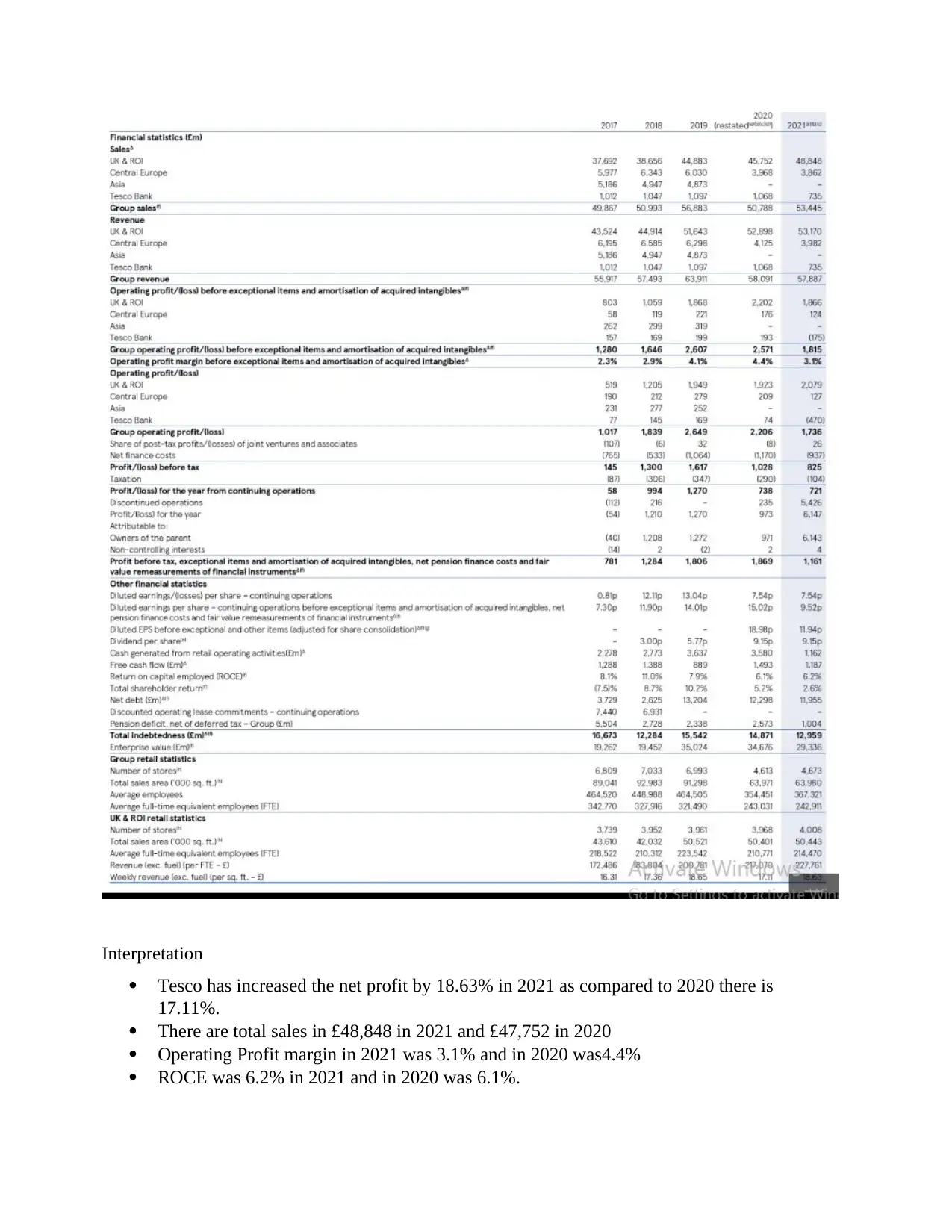
Interpretation
Tesco has increased the net profit by 18.63% in 2021 as compared to 2020 there is
17.11%.
There are total sales in £48,848 in 2021 and £47,752 in 2020
Operating Profit margin in 2021 was 3.1% and in 2020 was4.4%
ROCE was 6.2% in 2021 and in 2020 was 6.1%.
Tesco has increased the net profit by 18.63% in 2021 as compared to 2020 there is
17.11%.
There are total sales in £48,848 in 2021 and £47,752 in 2020
Operating Profit margin in 2021 was 3.1% and in 2020 was4.4%
ROCE was 6.2% in 2021 and in 2020 was 6.1%.
Paraphrase This Document
Need a fresh take? Get an instant paraphrase of this document with our AI Paraphraser
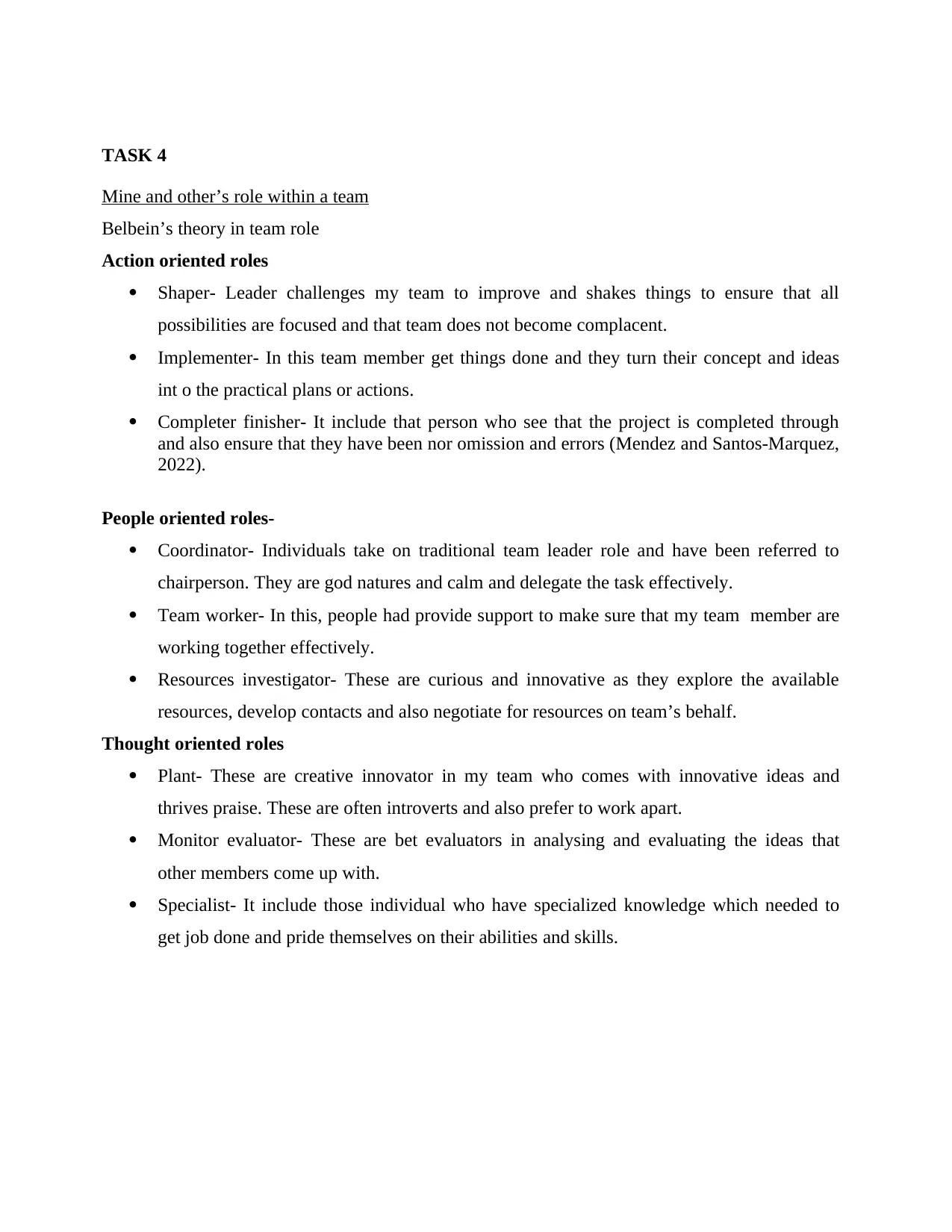
TASK 4
Mine and other’s role within a team
Belbein’s theory in team role
Action oriented roles
Shaper- Leader challenges my team to improve and shakes things to ensure that all
possibilities are focused and that team does not become complacent.
Implementer- In this team member get things done and they turn their concept and ideas
int o the practical plans or actions.
Completer finisher- It include that person who see that the project is completed through
and also ensure that they have been nor omission and errors (Mendez and Santos-Marquez,
2022).
People oriented roles-
Coordinator- Individuals take on traditional team leader role and have been referred to
chairperson. They are god natures and calm and delegate the task effectively.
Team worker- In this, people had provide support to make sure that my team member are
working together effectively.
Resources investigator- These are curious and innovative as they explore the available
resources, develop contacts and also negotiate for resources on team’s behalf.
Thought oriented roles
Plant- These are creative innovator in my team who comes with innovative ideas and
thrives praise. These are often introverts and also prefer to work apart.
Monitor evaluator- These are bet evaluators in analysing and evaluating the ideas that
other members come up with.
Specialist- It include those individual who have specialized knowledge which needed to
get job done and pride themselves on their abilities and skills.
Mine and other’s role within a team
Belbein’s theory in team role
Action oriented roles
Shaper- Leader challenges my team to improve and shakes things to ensure that all
possibilities are focused and that team does not become complacent.
Implementer- In this team member get things done and they turn their concept and ideas
int o the practical plans or actions.
Completer finisher- It include that person who see that the project is completed through
and also ensure that they have been nor omission and errors (Mendez and Santos-Marquez,
2022).
People oriented roles-
Coordinator- Individuals take on traditional team leader role and have been referred to
chairperson. They are god natures and calm and delegate the task effectively.
Team worker- In this, people had provide support to make sure that my team member are
working together effectively.
Resources investigator- These are curious and innovative as they explore the available
resources, develop contacts and also negotiate for resources on team’s behalf.
Thought oriented roles
Plant- These are creative innovator in my team who comes with innovative ideas and
thrives praise. These are often introverts and also prefer to work apart.
Monitor evaluator- These are bet evaluators in analysing and evaluating the ideas that
other members come up with.
Specialist- It include those individual who have specialized knowledge which needed to
get job done and pride themselves on their abilities and skills.
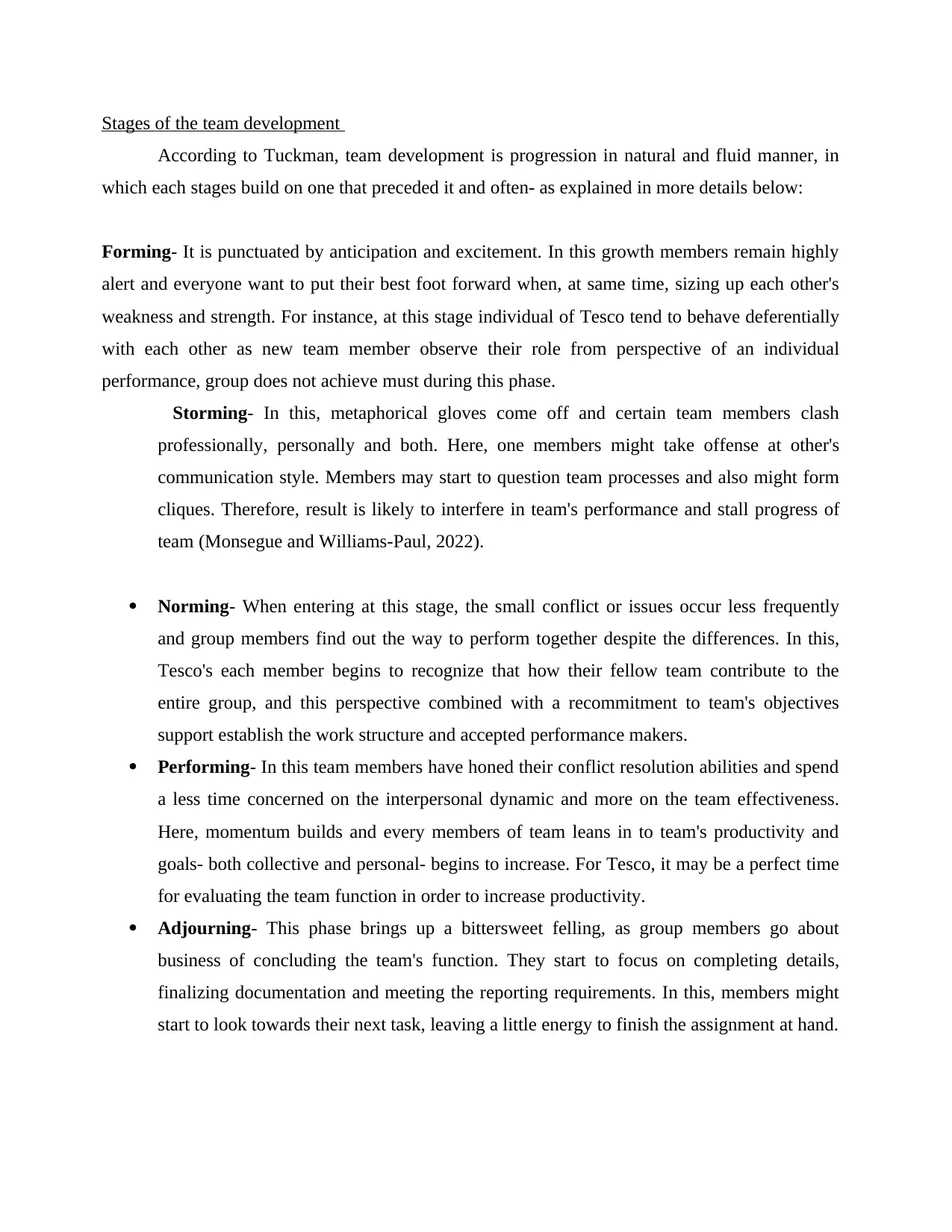
Stages of the team development
According to Tuckman, team development is progression in natural and fluid manner, in
which each stages build on one that preceded it and often- as explained in more details below:
Forming- It is punctuated by anticipation and excitement. In this growth members remain highly
alert and everyone want to put their best foot forward when, at same time, sizing up each other's
weakness and strength. For instance, at this stage individual of Tesco tend to behave deferentially
with each other as new team member observe their role from perspective of an individual
performance, group does not achieve must during this phase.
Storming- In this, metaphorical gloves come off and certain team members clash
professionally, personally and both. Here, one members might take offense at other's
communication style. Members may start to question team processes and also might form
cliques. Therefore, result is likely to interfere in team's performance and stall progress of
team (Monsegue and Williams-Paul, 2022).
Norming- When entering at this stage, the small conflict or issues occur less frequently
and group members find out the way to perform together despite the differences. In this,
Tesco's each member begins to recognize that how their fellow team contribute to the
entire group, and this perspective combined with a recommitment to team's objectives
support establish the work structure and accepted performance makers.
Performing- In this team members have honed their conflict resolution abilities and spend
a less time concerned on the interpersonal dynamic and more on the team effectiveness.
Here, momentum builds and every members of team leans in to team's productivity and
goals- both collective and personal- begins to increase. For Tesco, it may be a perfect time
for evaluating the team function in order to increase productivity.
Adjourning- This phase brings up a bittersweet felling, as group members go about
business of concluding the team's function. They start to focus on completing details,
finalizing documentation and meeting the reporting requirements. In this, members might
start to look towards their next task, leaving a little energy to finish the assignment at hand.
According to Tuckman, team development is progression in natural and fluid manner, in
which each stages build on one that preceded it and often- as explained in more details below:
Forming- It is punctuated by anticipation and excitement. In this growth members remain highly
alert and everyone want to put their best foot forward when, at same time, sizing up each other's
weakness and strength. For instance, at this stage individual of Tesco tend to behave deferentially
with each other as new team member observe their role from perspective of an individual
performance, group does not achieve must during this phase.
Storming- In this, metaphorical gloves come off and certain team members clash
professionally, personally and both. Here, one members might take offense at other's
communication style. Members may start to question team processes and also might form
cliques. Therefore, result is likely to interfere in team's performance and stall progress of
team (Monsegue and Williams-Paul, 2022).
Norming- When entering at this stage, the small conflict or issues occur less frequently
and group members find out the way to perform together despite the differences. In this,
Tesco's each member begins to recognize that how their fellow team contribute to the
entire group, and this perspective combined with a recommitment to team's objectives
support establish the work structure and accepted performance makers.
Performing- In this team members have honed their conflict resolution abilities and spend
a less time concerned on the interpersonal dynamic and more on the team effectiveness.
Here, momentum builds and every members of team leans in to team's productivity and
goals- both collective and personal- begins to increase. For Tesco, it may be a perfect time
for evaluating the team function in order to increase productivity.
Adjourning- This phase brings up a bittersweet felling, as group members go about
business of concluding the team's function. They start to focus on completing details,
finalizing documentation and meeting the reporting requirements. In this, members might
start to look towards their next task, leaving a little energy to finish the assignment at hand.
⊘ This is a preview!⊘
Do you want full access?
Subscribe today to unlock all pages.

Trusted by 1+ million students worldwide
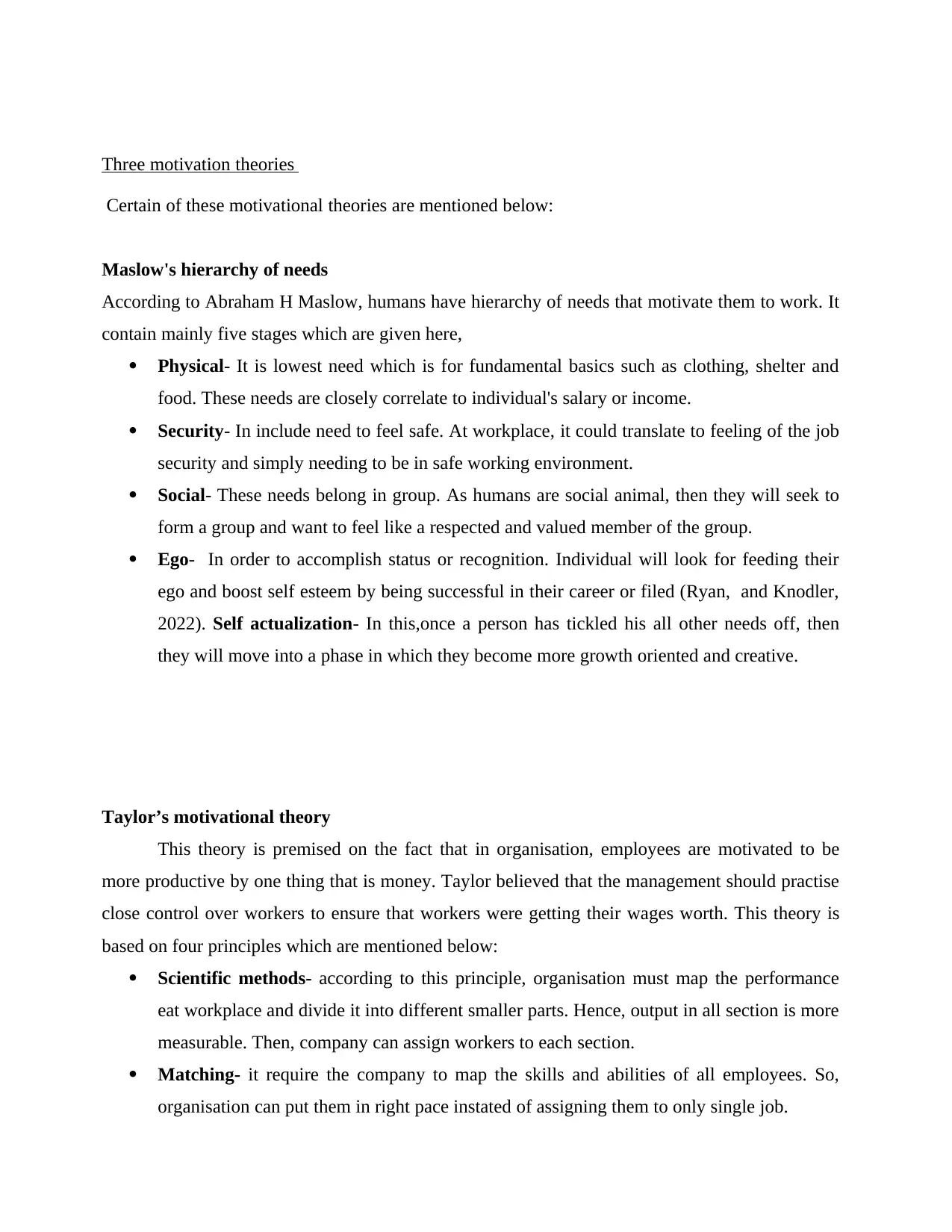
Three motivation theories
Certain of these motivational theories are mentioned below:
Maslow's hierarchy of needs
According to Abraham H Maslow, humans have hierarchy of needs that motivate them to work. It
contain mainly five stages which are given here,
Physical- It is lowest need which is for fundamental basics such as clothing, shelter and
food. These needs are closely correlate to individual's salary or income.
Security- In include need to feel safe. At workplace, it could translate to feeling of the job
security and simply needing to be in safe working environment.
Social- These needs belong in group. As humans are social animal, then they will seek to
form a group and want to feel like a respected and valued member of the group.
Ego- In order to accomplish status or recognition. Individual will look for feeding their
ego and boost self esteem by being successful in their career or filed (Ryan, and Knodler,
2022). Self actualization- In this,once a person has tickled his all other needs off, then
they will move into a phase in which they become more growth oriented and creative.
Taylor’s motivational theory
This theory is premised on the fact that in organisation, employees are motivated to be
more productive by one thing that is money. Taylor believed that the management should practise
close control over workers to ensure that workers were getting their wages worth. This theory is
based on four principles which are mentioned below:
Scientific methods- according to this principle, organisation must map the performance
eat workplace and divide it into different smaller parts. Hence, output in all section is more
measurable. Then, company can assign workers to each section.
Matching- it require the company to map the skills and abilities of all employees. So,
organisation can put them in right pace instated of assigning them to only single job.
Certain of these motivational theories are mentioned below:
Maslow's hierarchy of needs
According to Abraham H Maslow, humans have hierarchy of needs that motivate them to work. It
contain mainly five stages which are given here,
Physical- It is lowest need which is for fundamental basics such as clothing, shelter and
food. These needs are closely correlate to individual's salary or income.
Security- In include need to feel safe. At workplace, it could translate to feeling of the job
security and simply needing to be in safe working environment.
Social- These needs belong in group. As humans are social animal, then they will seek to
form a group and want to feel like a respected and valued member of the group.
Ego- In order to accomplish status or recognition. Individual will look for feeding their
ego and boost self esteem by being successful in their career or filed (Ryan, and Knodler,
2022). Self actualization- In this,once a person has tickled his all other needs off, then
they will move into a phase in which they become more growth oriented and creative.
Taylor’s motivational theory
This theory is premised on the fact that in organisation, employees are motivated to be
more productive by one thing that is money. Taylor believed that the management should practise
close control over workers to ensure that workers were getting their wages worth. This theory is
based on four principles which are mentioned below:
Scientific methods- according to this principle, organisation must map the performance
eat workplace and divide it into different smaller parts. Hence, output in all section is more
measurable. Then, company can assign workers to each section.
Matching- it require the company to map the skills and abilities of all employees. So,
organisation can put them in right pace instated of assigning them to only single job.
Paraphrase This Document
Need a fresh take? Get an instant paraphrase of this document with our AI Paraphraser
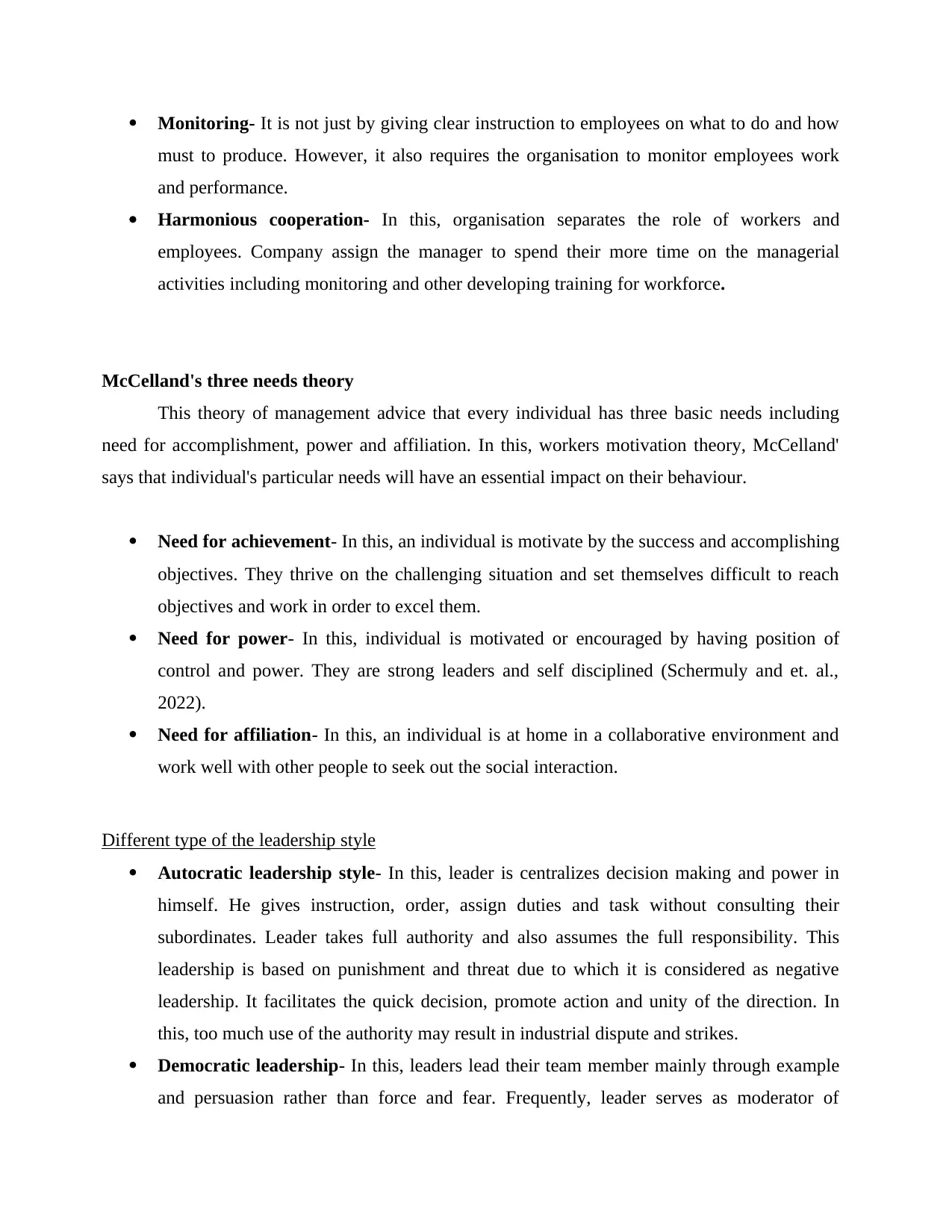
Monitoring- It is not just by giving clear instruction to employees on what to do and how
must to produce. However, it also requires the organisation to monitor employees work
and performance.
Harmonious cooperation- In this, organisation separates the role of workers and
employees. Company assign the manager to spend their more time on the managerial
activities including monitoring and other developing training for workforce.
McCelland's three needs theory
This theory of management advice that every individual has three basic needs including
need for accomplishment, power and affiliation. In this, workers motivation theory, McCelland'
says that individual's particular needs will have an essential impact on their behaviour.
Need for achievement- In this, an individual is motivate by the success and accomplishing
objectives. They thrive on the challenging situation and set themselves difficult to reach
objectives and work in order to excel them.
Need for power- In this, individual is motivated or encouraged by having position of
control and power. They are strong leaders and self disciplined (Schermuly and et. al.,
2022).
Need for affiliation- In this, an individual is at home in a collaborative environment and
work well with other people to seek out the social interaction.
Different type of the leadership style
Autocratic leadership style- In this, leader is centralizes decision making and power in
himself. He gives instruction, order, assign duties and task without consulting their
subordinates. Leader takes full authority and also assumes the full responsibility. This
leadership is based on punishment and threat due to which it is considered as negative
leadership. It facilitates the quick decision, promote action and unity of the direction. In
this, too much use of the authority may result in industrial dispute and strikes.
Democratic leadership- In this, leaders lead their team member mainly through example
and persuasion rather than force and fear. Frequently, leader serves as moderator of
must to produce. However, it also requires the organisation to monitor employees work
and performance.
Harmonious cooperation- In this, organisation separates the role of workers and
employees. Company assign the manager to spend their more time on the managerial
activities including monitoring and other developing training for workforce.
McCelland's three needs theory
This theory of management advice that every individual has three basic needs including
need for accomplishment, power and affiliation. In this, workers motivation theory, McCelland'
says that individual's particular needs will have an essential impact on their behaviour.
Need for achievement- In this, an individual is motivate by the success and accomplishing
objectives. They thrive on the challenging situation and set themselves difficult to reach
objectives and work in order to excel them.
Need for power- In this, individual is motivated or encouraged by having position of
control and power. They are strong leaders and self disciplined (Schermuly and et. al.,
2022).
Need for affiliation- In this, an individual is at home in a collaborative environment and
work well with other people to seek out the social interaction.
Different type of the leadership style
Autocratic leadership style- In this, leader is centralizes decision making and power in
himself. He gives instruction, order, assign duties and task without consulting their
subordinates. Leader takes full authority and also assumes the full responsibility. This
leadership is based on punishment and threat due to which it is considered as negative
leadership. It facilitates the quick decision, promote action and unity of the direction. In
this, too much use of the authority may result in industrial dispute and strikes.
Democratic leadership- In this, leaders lead their team member mainly through example
and persuasion rather than force and fear. Frequently, leader serves as moderator of
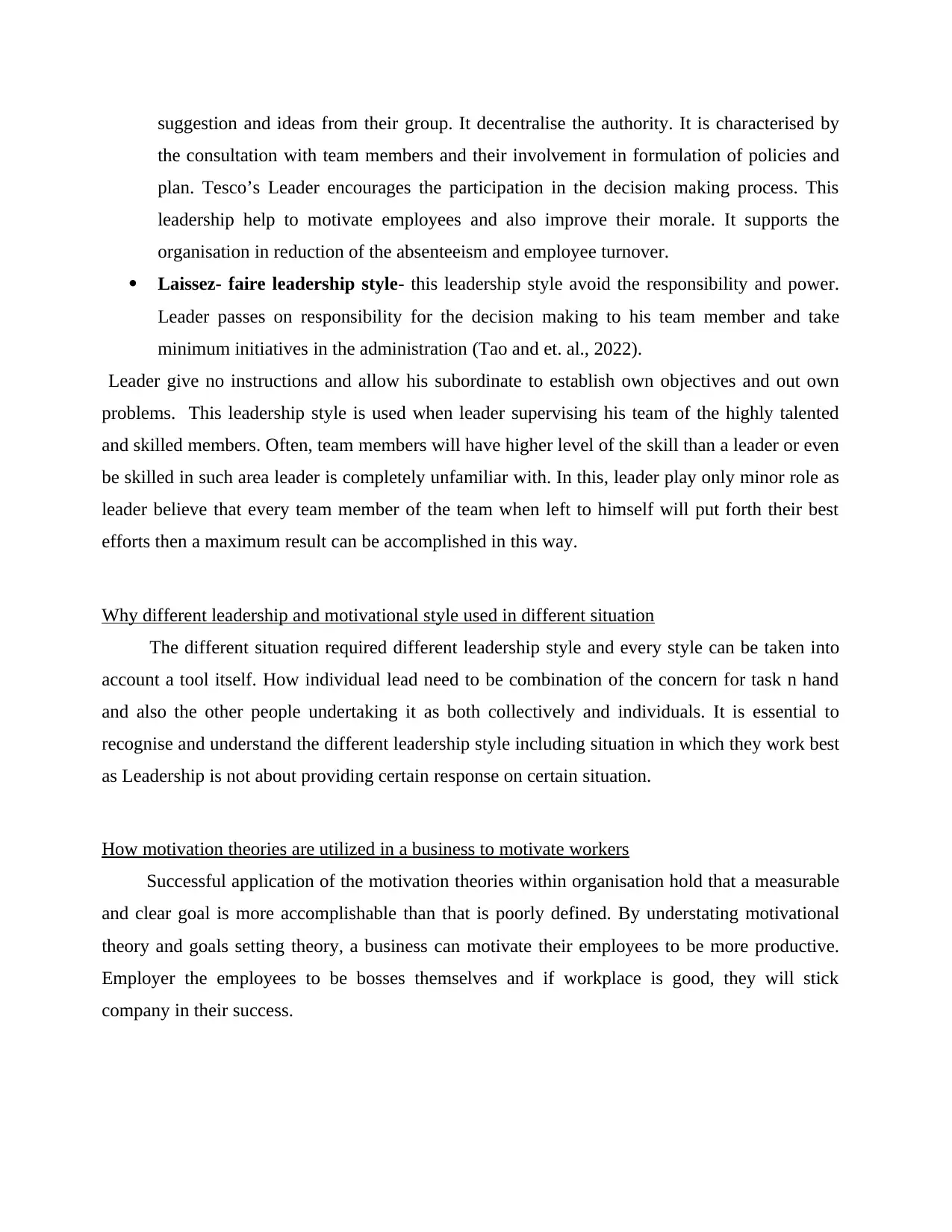
suggestion and ideas from their group. It decentralise the authority. It is characterised by
the consultation with team members and their involvement in formulation of policies and
plan. Tesco’s Leader encourages the participation in the decision making process. This
leadership help to motivate employees and also improve their morale. It supports the
organisation in reduction of the absenteeism and employee turnover.
Laissez- faire leadership style- this leadership style avoid the responsibility and power.
Leader passes on responsibility for the decision making to his team member and take
minimum initiatives in the administration (Tao and et. al., 2022).
Leader give no instructions and allow his subordinate to establish own objectives and out own
problems. This leadership style is used when leader supervising his team of the highly talented
and skilled members. Often, team members will have higher level of the skill than a leader or even
be skilled in such area leader is completely unfamiliar with. In this, leader play only minor role as
leader believe that every team member of the team when left to himself will put forth their best
efforts then a maximum result can be accomplished in this way.
Why different leadership and motivational style used in different situation
The different situation required different leadership style and every style can be taken into
account a tool itself. How individual lead need to be combination of the concern for task n hand
and also the other people undertaking it as both collectively and individuals. It is essential to
recognise and understand the different leadership style including situation in which they work best
as Leadership is not about providing certain response on certain situation.
How motivation theories are utilized in a business to motivate workers
Successful application of the motivation theories within organisation hold that a measurable
and clear goal is more accomplishable than that is poorly defined. By understating motivational
theory and goals setting theory, a business can motivate their employees to be more productive.
Employer the employees to be bosses themselves and if workplace is good, they will stick
company in their success.
the consultation with team members and their involvement in formulation of policies and
plan. Tesco’s Leader encourages the participation in the decision making process. This
leadership help to motivate employees and also improve their morale. It supports the
organisation in reduction of the absenteeism and employee turnover.
Laissez- faire leadership style- this leadership style avoid the responsibility and power.
Leader passes on responsibility for the decision making to his team member and take
minimum initiatives in the administration (Tao and et. al., 2022).
Leader give no instructions and allow his subordinate to establish own objectives and out own
problems. This leadership style is used when leader supervising his team of the highly talented
and skilled members. Often, team members will have higher level of the skill than a leader or even
be skilled in such area leader is completely unfamiliar with. In this, leader play only minor role as
leader believe that every team member of the team when left to himself will put forth their best
efforts then a maximum result can be accomplished in this way.
Why different leadership and motivational style used in different situation
The different situation required different leadership style and every style can be taken into
account a tool itself. How individual lead need to be combination of the concern for task n hand
and also the other people undertaking it as both collectively and individuals. It is essential to
recognise and understand the different leadership style including situation in which they work best
as Leadership is not about providing certain response on certain situation.
How motivation theories are utilized in a business to motivate workers
Successful application of the motivation theories within organisation hold that a measurable
and clear goal is more accomplishable than that is poorly defined. By understating motivational
theory and goals setting theory, a business can motivate their employees to be more productive.
Employer the employees to be bosses themselves and if workplace is good, they will stick
company in their success.
⊘ This is a preview!⊘
Do you want full access?
Subscribe today to unlock all pages.

Trusted by 1+ million students worldwide
1 out of 14
Related Documents
Your All-in-One AI-Powered Toolkit for Academic Success.
+13062052269
info@desklib.com
Available 24*7 on WhatsApp / Email
![[object Object]](/_next/static/media/star-bottom.7253800d.svg)
Unlock your academic potential
Copyright © 2020–2025 A2Z Services. All Rights Reserved. Developed and managed by ZUCOL.





